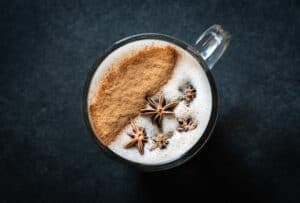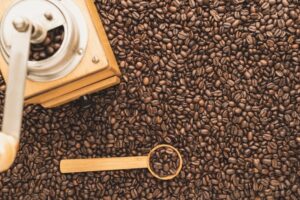Comparing a latte and chai has always prompted a question: “Is Latte the Same as Chai?” This question usually arises whenever we want to order at a coffee shop. As we explore their unique flavor profiles and preparation methods,, we discover the differences between these two popular beverages.
Contents
Is Latte the Same as Chai?
A latte and chai are two distinct drinks with different origins. Latte, which means milk in Italian, is made by mixing espresso with steamed milk. Chai comes from the Hindi word for tea and commonly refers to a spiced tea drink.
Lattes have a specific ratio of espresso to milk, predominantly from 1:2 to 1:3, and are topped with a foamy layer.
Lattes are not just about taste, they also involve art. Baristas are known for their creativity with their latte art skills. They craft gorgeous designs on the foam, like hearts, rosettas, and even intricate patterns.

How to Make a Latte
Preparing a latte coffee is a fairly straightforward technique you can use at home with an espresso machine and a milk frother. Frothing the milk is the most essential skill to muster when making a latte. The steps applied in making a latte include:
Prepare the Espresso
Start by making about one or two espresso shots using your machine. Pour it into the base of your 16-ounce heatproof coffee mug. If you love an extra hot latte, fill your mug with boiling water and pour it out before adding your espresso.
Steam the Milk
Pour some milk into a frothing pitcher that can hold at least 12 ounces. Next, insert the steam wand into the milk at a diagonal angle and activate the steam function. Position the wand’s tip below the milk’s surface and secure it against the pitcher’s spout to maintain the desired diagonal orientation.
In the case of most home espresso machines, allow the steam to heat the milk for approximately 10 seconds or until 150 degrees Fahrenheit.
Then, gradually lower the wand’s tip slightly deeper into the milk, continuing this motion for about 15 seconds. Aim for a creamy and velvety appearance, with minimal foam on the surface.
Add Finishing Touches
Gently drizzle the frothy milk over the espresso you made earlier in a gradual, slender cascade while employing a spoon to retain the froth. In the case of a 12-ounce latte, the froth typically settles to a thickness resembling that of a slender twig.
Types of Lattes
Coffee shops are a wonderland of latte options! You’ve probably noticed the extensive list of latte flavors on the menu. Though have you ever wondered how many types of lattes are out there? The possibilities are endless!
- Caffe Latte: This latte is crafted with espresso and steamed milk. It’s the perfect base for all other types of lattes.
- Vanilla Latte: Sweet and smooth, this latte has a shot of vanilla syrup added to the espresso before the steamed milk is poured in.
- Caramel Latte: Looking for a bit of deliciousness in your life? A caramel latte has a drizzle of caramel syrup added to a ristretto. Afterward, steamed milk is poured in.
- Mocha Latte: Mocha latte is ideally suited for chocolate fanatics out there. It adds chocolate syrup or powder to the espresso and steamed milk.
- Matcha Latte: This refreshing drink is formulated using matcha powder, a finely ground green tea powder mixed with steamed milk to produce a vibrant green hue and a slightly earthy flavor.

How to Make Chai
Making chai at home is more manageable when compared to making a latte and needs only a few ingredients. The steps involved include:
- Brew the tea: Boil water in a pot and add loose-leaf black tea or tea bags. Let it steep for 3-5 minutes, depending on the desired strength.
- Add the spices and milk: Simmer the spices in the pot for 5-10 minutes to allow their flavors to permeate the tea. Add the milk and allow it to steam.
- Sweeten the chai: For added taste, include honey or sugar.
Types of Chai
Like lattes, chai has also become popular, and you can now find a variety of chai flavors and blends.
- Masala chai: A popular type of tea, typically prepared by mixing black tea with various spices.
- Ginger chai: Chai that’s spiced with ginger, which adds a spicy and warming flavor.
- Cardamom chai: Adding cardamom to your chai imparts a sweet and floral note, making it more delightful.
- Rooibos chai: Chai that’s made with rooibos tea instead of black tea, which has a sweeter and nuttier flavor.
Differences Between Latte and Chai
Lattes and chai may have milk in common, though they’re like two different planets in the flavor universe! So how do you choose between the two?
Flavor Profile
Lattes are like the smooth-talking charmer of the coffee world. They’ve got a bold, rich coffee flavor tamed by the milk’s sweetness and creaminess.
Takeaway: You could be contemplating, is a latte bitter? It’s possible, depending on the coffee used, though you can add milk and sweeteners to offset the bitterness.
Meanwhile, chai is the spice-loving rebel with an earthy, spicy flavor counterbalanced by sweet milk and a touch of sugar.
Preparation Method
Lattes involve the use of espresso and steamed milk. Meanwhile, chai is brewed with tea and a combination of spices, milk, and sweetener, requiring a longer, more gradual process to achieve a delicious outcome.
Takeaway: Maybe you’re curious, “Is a latte hot or cold?” Lattes are served hot, though they can also be enjoyed cold.
Caffeine Content
Lattes have a higher caffeine content than chai since they’re made with espresso. Espresso is primarily brewed using the best coffee beans for a latte. The result is a stronger concentration of caffeine than coffee or tea-based drinks like chai.

Which One Is Healthier?
Comparatively, lattes tend to be more calorific and fatty than chai, mainly because of whole milk and whipped cream. In contrast, chai is relatively low in calories and fat, although it can contain high sugar levels if sweetened with honey or sugar.
Both beverages are rich in antioxidants. These chemicals are essential for fighting inflammation and oxidative stress. Caffeine in lattes also enhances brain function and reduces the risk of liver disease and type 2 diabetes. Here’s a summary of the nutritional information for a latte and chai made with whole milk and a sweetener.
Nutrition facts for a 12-ounce latte:
- Calories: 210
- Fat: 9 grams
- Carbohydrates: 20 grams
- Protein: 11 grams
Nutrition facts for a 12-ounce chai:
- Calories: 120
- Fat: 5 grams
- Carbohydrates: 18 grams
- Protein: 5 grams
Related Questions
Which Drink Is More Popular, Latte or Chai?
The popularity of lattes and chai can differ depending on location and individual pick. In the United States, lattes are more popular, while chai is an everyday option in India and other parts of Asia.
Are Lattes and Chai Available in Decaf Versions?
Lattes and chai are available in decaf versions. It’s worth considering that the taste and nutritional value may contrast with their regular caffeinated versions. Decaf lattes are made with decaf espresso, while decaf chai is crafted using decaffeinated tea.
Are There Any Health Risks Associated With Drinking Lattes or Chai?
Generally speaking, lattes and chai are safe to consume in moderation for most people. Excess caffeine can cause jitters, anxiety, and insomnia. Adding high amounts of sugar or fat to either drink can increase the risk of obesity and diabetes.
Conclusion
Lattes and chai contain milk but have different flavor profiles, preparation methods, and nutritional values. Lattes have a strong coffee flavor, while chai has a spicier and earthier flavor. Lattes have espresso and steamed milk, while chai is made by brewing tea with spices and milk.



